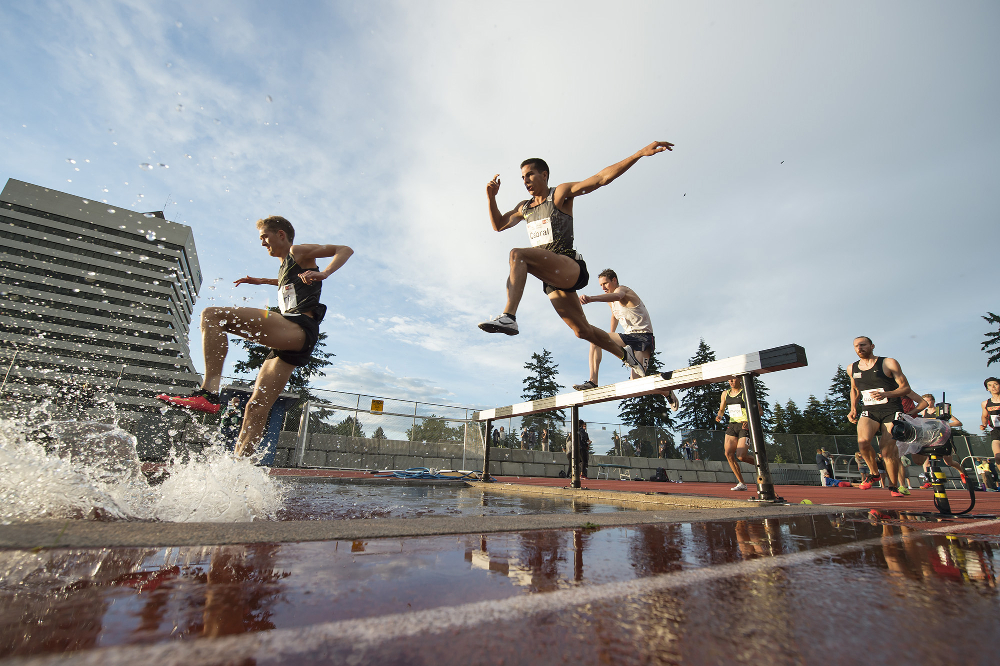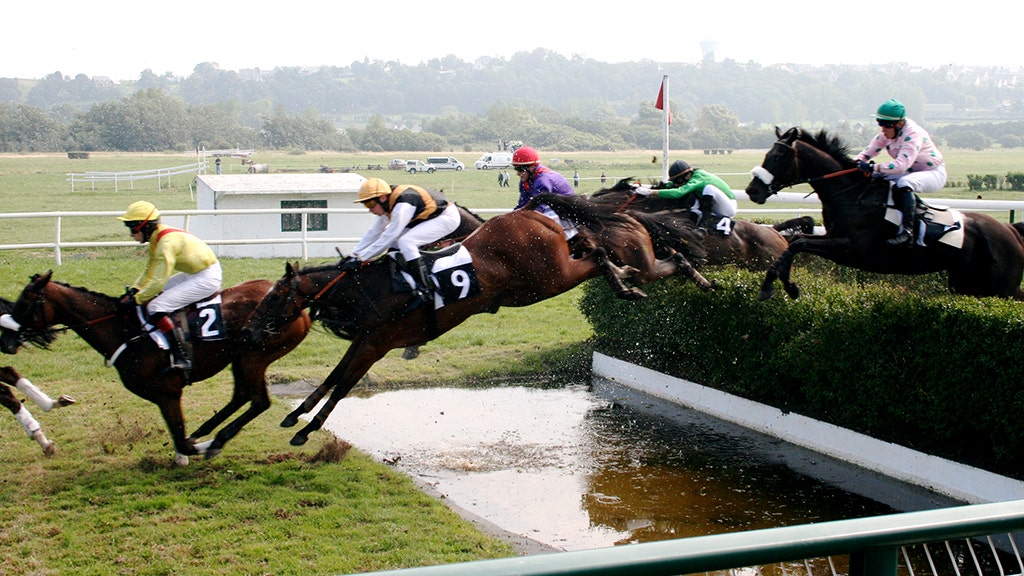The Mechanics of a Steeplechase Fall

The steeplechase, with its demanding combination of speed, endurance, and technical obstacles, presents unique challenges for athletes. One of the most dramatic and potentially dangerous aspects of the race is the possibility of a fall. Understanding the mechanics behind these falls is crucial for both athletes and spectators, offering insights into the intricate interplay of physical factors, technique, and mental fortitude.
Causes of Falls in Steeplechase Races
Falls in steeplechase races can occur due to a variety of factors, each contributing to the delicate balance required to navigate the course safely.
- Foot Placement and Stride Length: The steeplechase course demands precise foot placement, particularly when approaching the water jump. A misstep, whether due to fatigue or misjudgment, can lead to a loss of balance and a fall. The stride length, too, plays a crucial role. A stride that is too long or too short can disrupt the runner’s rhythm and increase the risk of a stumble.
- Technical Errors at the Water Jump: The water jump, a defining feature of the steeplechase, presents a significant challenge. Improper technique, such as a poorly timed leap or a failure to maintain balance during the landing, can easily result in a fall. The runner’s ability to maintain momentum while clearing the water, coupled with a smooth and controlled landing, is paramount.
- Fatigue and Mental Focus: As the race progresses, fatigue takes its toll on the athletes. The relentless pace and the demanding nature of the obstacles can lead to diminished focus and impaired decision-making. Fatigue can also affect muscle coordination and reaction time, increasing the likelihood of a misstep or a fall.
The Water Jump and its Potential Pitfalls
The water jump, a unique obstacle in the steeplechase, requires precise timing, balance, and technique. A misstep at this hurdle can have severe consequences, potentially leading to a fall and a loss of valuable time.
“The water jump is the most challenging obstacle in the steeplechase. It requires a perfect combination of speed, timing, and technique to clear the barrier and land safely on the other side.” – Steve Cram, former Olympic steeplechase champion
- Timing and Approach: The runner’s approach to the water jump is crucial. A well-timed leap, ensuring sufficient momentum to clear the barrier, is essential. A late approach can lead to a rushed leap, increasing the risk of a fall. The runner must maintain a steady rhythm and pace, ensuring a smooth transition from the previous hurdle to the water jump.
- Leap and Clearance: The leap itself requires precision and control. The runner must lift their legs high enough to clear the barrier without losing their balance. A forceful push-off from the ground, coupled with a strong arm swing, helps propel the athlete over the obstacle. The runner’s center of gravity must be aligned correctly to maintain stability throughout the leap.
- Landing and Recovery: The landing after the water jump is equally important. The runner must absorb the impact of landing on the other side of the barrier, maintaining balance and momentum. A smooth and controlled landing minimizes the risk of a stumble or a fall. The runner must be prepared to transition seamlessly into the next stride, minimizing any loss of time or momentum.
Impact of Fatigue and Mental Focus on Stability
Fatigue, a constant companion in long-distance running, plays a significant role in the stability of steeplechase runners. As the race progresses, the cumulative effects of physical exertion can lead to diminished focus, impaired coordination, and reduced reaction time. This can significantly increase the risk of a fall, especially when navigating the challenging obstacles.
- Diminished Focus and Decision-Making: Fatigue can lead to a decline in mental focus, making it difficult for runners to make quick and accurate decisions, particularly when approaching the obstacles. The runner’s ability to assess the situation and react appropriately can be compromised, increasing the risk of a misstep or a fall.
- Muscle Fatigue and Coordination: As the race progresses, muscle fatigue sets in, affecting the runner’s coordination and balance. The muscles become weaker and less responsive, making it more difficult to maintain stability, especially when navigating the technical obstacles.
- Reaction Time and Agility: Fatigue can also impair the runner’s reaction time and agility. This can make it difficult to react quickly to unforeseen obstacles or changes in the terrain, increasing the risk of a fall.
Types of Falls and Their Consequences
Falls in steeplechase races can occur in various ways, each with its own set of potential consequences. Understanding the different types of falls and their associated risks is essential for both athletes and coaches.
| Type of Fall | Description | Consequences |
|---|---|---|
| Stumble | A minor loss of balance, often caused by a misstep or uneven terrain. | Minor injuries, such as scrapes or bruises. May result in a loss of time and position. |
| Trip | A more severe loss of balance, often caused by an obstacle or a change in elevation. | Moderate injuries, such as sprains or fractures. May lead to a significant loss of time and position. |
| Fall Over the Barrier | A complete loss of balance, often resulting in the runner falling over the obstacle. | Severe injuries, such as dislocations or head trauma. May result in a disqualification from the race. |
| Fall into the Water | A fall into the water jump, often caused by a misstep or a failed leap. | Water-related injuries, such as hypothermia or drowning. May result in a significant loss of time and position. |
The Impact of a Steeplechase Fall: Men’s Steeplechase Fall

The steeplechase, a demanding and thrilling event, often involves high-speed running and challenging obstacles. While the thrill of the race is undeniable, the potential for falls is a constant factor. These falls can range from minor stumbles to serious accidents, with consequences that impact both the physical and mental well-being of the athlete.
The Severity of Steeplechase Falls
The severity of a steeplechase fall can vary greatly, depending on factors such as the height of the fall, the impact surface, and the runner’s position at the time of the fall. Falls can result in a wide range of injuries, from minor sprains and bruises to severe fractures and head injuries.
Here is a table outlining the different levels of severity of falls and their potential recovery timeframes:
| Severity | Potential Injuries | Recovery Timeframe |
|---|---|---|
| Minor | Sprains, bruises, minor cuts | Days to weeks |
| Moderate | Fractures, ligament tears, concussion | Weeks to months |
| Severe | Multiple fractures, severe head injuries, internal bleeding | Months to years |
Real-World Examples of Steeplechase Falls
Several high-profile steeplechase falls have highlighted the potential for serious injuries in the sport. In 2012, Olympic champion Ezekiel Kemboi fell during the final lap of the Olympic steeplechase, ultimately costing him a medal. The impact of the fall resulted in a minor ankle injury, which required several weeks of recovery. Another notable example is the fall of Kenyan runner Brimin Kipruto in the 2016 Rio Olympics. Kipruto, a former world champion, fell during the race and sustained a serious leg injury that required surgery. He was unable to compete for several months, highlighting the long-term impact of a severe fall.
The Psychological Impact of a Fall
A steeplechase fall can have a significant psychological impact on a runner’s performance and confidence. The fear of falling can be debilitating, leading to hesitation and a loss of focus during the race. Additionally, the physical and emotional pain associated with a fall can affect a runner’s mental state, impacting their ability to train and compete effectively. Overcoming the psychological effects of a fall requires a combination of physical recovery, mental resilience, and support from coaches and teammates.
Preventing Steeplechase Falls

Steeplechase running, with its challenging obstacles, demands exceptional balance, coordination, and stability. A fall can not only disrupt a runner’s race but also lead to serious injuries. This section explores various techniques, strategies, and equipment that can significantly reduce the risk of falls in steeplechase.
Training Techniques and Strategies
A well-structured training program plays a crucial role in preventing falls. Focusing on balance and stability exercises can significantly improve a runner’s ability to navigate obstacles safely.
- Balance Drills: Single-leg squats, lunges, and standing on one leg with eyes closed are effective exercises for enhancing balance and proprioception. These drills train the body to maintain equilibrium under various conditions, including uneven terrain.
- Coordination Exercises: Agility drills, ladder drills, and plyometric exercises improve coordination and reaction time, allowing runners to adjust quickly to changing conditions and obstacle challenges.
- Core Strengthening: A strong core provides stability and control during the run, reducing the risk of falls. Exercises like planks, crunches, and Russian twists strengthen the core muscles, enhancing overall stability.
The Role of Equipment and Footwear
Appropriate equipment and footwear can play a significant role in minimizing the risk of falls.
- Shoes: Steeplechase shoes with a good grip, adequate cushioning, and a supportive upper are essential for safe obstacle negotiation. Spikes provide traction on the track and water jump, reducing the likelihood of slipping.
- Clothing: Loose-fitting clothing can hinder movement and increase the risk of falls. Tight-fitting, breathable clothing that allows for freedom of movement is recommended.
Tips for Minimizing Falls, Men’s steeplechase fall
A combination of training, equipment, and race-day strategies can help runners minimize the risk of falls.
- Obstacle Approach: Approaching obstacles with a controlled pace and maintaining a stable body position is crucial. Runners should focus on their foot placement and avoid rushing or overextending their stride.
- Water Jump Technique: The water jump is a major source of falls. Runners should practice proper technique, maintaining a low center of gravity and focusing on smooth transitions over the barrier.
- Staying Hydrated: Dehydration can lead to fatigue and poor judgment, increasing the risk of falls. Runners should ensure adequate hydration before, during, and after the race.
- Warm-Up and Cool-Down: A proper warm-up prepares the body for the demands of the race, while a cool-down helps prevent muscle soreness and stiffness.
Strengthening Core Muscles and Improving Coordination
Strengthening core muscles and improving coordination are essential for preventing falls in steeplechase. Here are some drills and exercises designed to enhance these areas:
- Plank: This exercise strengthens the core, back, and abdominal muscles, improving overall stability.
- Crunches: Crunches target the abdominal muscles, contributing to a stronger core.
- Russian Twists: This exercise strengthens the obliques and improves rotational stability.
- Agility Ladder Drills: Ladder drills improve coordination, footwork, and reaction time.
- Plyometric Jumps: Plyometrics enhance explosiveness and coordination, helping runners adjust to changing conditions.
The men’s steeplechase fall was a spectacle of chaos and misfortune, a moment of jarring stillness amidst the frenetic energy of the race. It’s a reminder that even the most meticulously planned movements can be undone by a single misstep, a twist of fate.
The graceful arc of a runner’s body, reminiscent of the curve of an aniline leather Eames chair , can be instantly disrupted, leaving a trail of dust and disappointment in its wake. The fall, however, is not the end, but a momentary pause, a chance for resilience to take hold, for the athlete to rise again, stronger and more determined.
The men’s steeplechase is a brutal sport, demanding both strength and agility. A single misstep, a stumble on the water jump, can send an athlete crashing to the ground, their hopes for victory dashed. But there’s a certain comfort in knowing that after the race, a plush recliner awaits, offering a respite from the grueling competition.
Perhaps a costco recliner chair leather would be the perfect choice, its soft, supple hide cradling weary muscles. Even the most seasoned athlete needs a moment to unwind, to let the adrenaline subside and the body recover, ready for the next challenge.